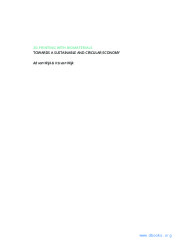3D Printing with Biomaterials
Download free course 3D Printing with Biomaterials, pdf file on 86 pages by IOS Press.../images/
3D printing holds the promise to manufacture with less waste and energy. We can print metals, ceramics, sand, synthetic materials such as plastics, food or living cells. However, the production of plastics is nowadays based on fossil fuels. And that's where we witness a paradigm change too. The production of these synthetic materials can be based also on biomaterials with biomass as feedstock.
A wealth of new and innovative products are emerging when we combine these two paradigm changes: 3D printing and biomaterials. Moreover, the combination of 3D printing with biomaterials holds the promise to realize a truly sustainable and circular economy.
Table of contents
-
3D Printing
-
Biomaterials
-
Towards a Sustainable and Circular Economy
| Pages : | 86 |
| Size : | 3.4 MB |
| File type : | |
| Downloads: | 68 |
| Created: | 2022-01-31 |
| License: | CC BY |
| Author(s): | IOS Press |

Warning: Trying to access array offset on false in /home/tutovnfz/public_html/article.php on line 233
Others Computer science Tutorials
The NGINX Real-Time API Handbook
Others related eBooks about 3D Printing with Biomaterials
The Little Book of SemaphoresThe Little Book of Semaphores is a free textbook that introduces the principles of synchro..., download free Semaphores tutorial in PDF (291 pages) created by ....
How to use computer for beginnersComputers and internet basics pdf tutorials, easy course for beginners to better understand the different uses of computer....
Visual Studio for Mac SuccinctlyDownload free course Visual Studio for Mac Succinctly, pdf file on 107 pages by Alessandro Del Sole....
Crypto 101Crypto 101 is an introductory course on cryptography, freely available for programmers of ..., download free Cryptography tutorial in PDF (254 pages) created by Laurens Van Houtven ....
Platform Embedded Security Technology RevealedPlatform Embedded Security Technology Revealed is an in-depth introduction to Intel's plat..., download free Security Technology tutorial in PDF (272 pages) created by Xiaoyu Ruan ....
Create Salesforce Scratch Org free PDFDownload free course Create Salesforce Scratch Org free PDF, pdf file on 7 pages by tutorialkart.com....
Power BI SuccinctlyDownload free course Power BI Succinctly, pdf file on 146 pages by Pierstefano Tucci....
Rethinking Productivity in Software EngineeringDownload free course Rethinking Productivity in Software Engineering, pdf file on 310 pages by Caitlin Sadowski, Thomas Zimmermann....
Adobe Photoshop CS Tips and Tricks from the Experts TutorialLearn how to use Photoshop like an expert in photography, graphic design, make a video, Web design and animation, tips, and tricks for all level-users....
Bayesian Methods for Hackers: Probabilistic Programming and Bayesian Inference Using Python and PyMCMaster Bayesian Inference through Practical Examples and Computation - Without Advanced Mathematical Analysis....